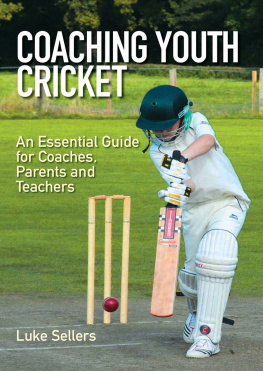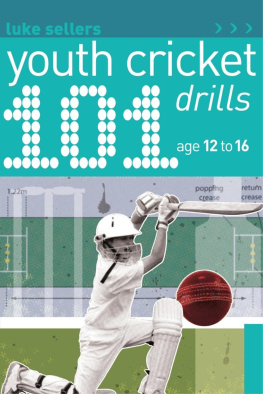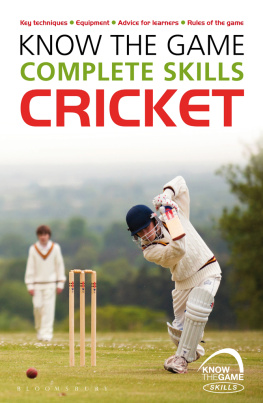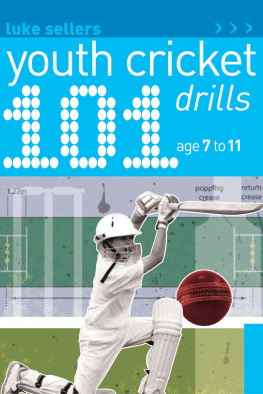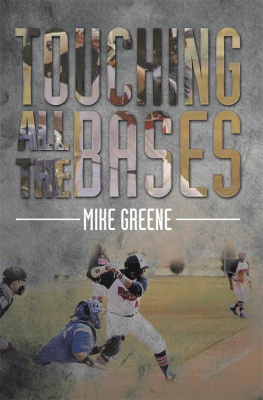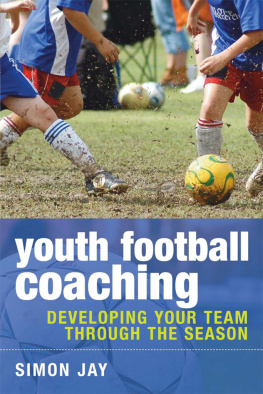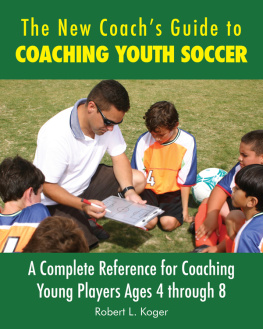
COACHING YOUTH
CRICKET
An Essential Guide for
Coaches, Parents and Teachers
Luke Sellers

First published in 2014 by
The Crowood Press Ltd
Ramsbury, Marlborough
Wiltshire SN8 2HR
www.crowood.com
Luke Sellers 2014
All rights reserved. No part of this publication may be reproduced or transmitted in any form or by any means, electronic or mechanical, including photocopy, recording, or any information storage and retrieval system, without permission in writing from the publishers.
British Library Cataloguing-in-Publication Data
A catalogue record for this book is available from the British Library.
ISBN 978 1 84797 795 3
Photography by Steve Cashmore
INTRODUCTION
Becoming a cricket coach is one of the most rewarding things I have done and continues to enthuse, surprise and inspire me. It is also a lot of fun.
The aim of this book isnt to tell you how to coach, it is simply to offer you some ideas to help you on your way. Whether you are a parent who is new to cricket and wanting to assist at your sons or daughters weekly training session, or a qualified coach running your own team, this book aims to equip you with all the tools you need to feel confident.
With crickets list of rules, idiosyncratic rules and variety of skills this can appear a daunting prospect especially if you havent played the game. But dont worry if you dont know a legspinner from an inswinger, because everything you need to know for coaching youth cricket, from top tips on technique to advice on managing match days, can be found in this book. Aimed at coaches working with children aged between seven and thirteen, the ideas, advice and practices in this book are designed to complement and enhance your own existing skills and coaching philosophy.
By giving your time to developing the next generation of cricketers you are a vital asset to your club, school or representative team. I hope you find coaching cricket a fulfilling and enjoyable experience, and I wish you all the very best of luck with it!
USING THIS BOOK
As this book is for coaches working with players aged from around seven to thirteen, the practices are designed to cover a wide range of abilities. To try to make sure the drills are relevant to coaches across these ages, the majority are aimed at players somewhere in the middle of this age range, for example under elevens. However, every drill contains ideas of how to make it harder, to make it suitable for older players, and ways to make it easier, to make it suitable for younger players. For an idea of what skills are most suited to your age group, see .

CHAPTER 1
PLAYER-CENTRED COACHING
A common mistake among those who work in sport is spending a disproportional amount of time on xs and os as compared to time spent learning about people.
Mike Krzyzewski, Basketball
What is Player-Centred Coaching?
Player-centred coaching is the idea of putting the player at the heart of the coaching process. It is the starting point for the England and Wales Cricket Boards (ECB) coach education courses, and is widely recognized across all sports as the underpinning theme of quality coaching. Although the needs of their groups will be very different, the method is just as relevant for coaches working with young players in a club environment as it is for those working with professionals at an lite level.
Outlining the benefits of the approach in their influential book Athlete-Centred Coaching: Developing Inspired and Inspiring People, Lynn Kidman, Rod Thorpe and David Hadfield suggest that a player-centred approach improves motivation and understanding and helps prepare players for competition:
Some of the main advantages of using an athlete-centred approach to coaching are that athletes are motivated to learn, and they have a greater understanding and retention of both tactics and skills
This approach is clearly beneficial given that athletes must be self-sufficient in their performance, decision-taking and option-taking while participating in their respective sport.
To start to think about the approach in practice and the benefits it might have, here is a quick-fire list of questions to think about in relation to a typical coaching session:
Who is the most important person in the coaching session?
Whose goals and ambitions should drive the session?
Who provides the answers and sets the challenges during the session?
Who is responsible for learning and skill development during the session?
Traditionally the answer to some or all of these questions may have been the coach, but if they are that central to a session, there is a danger they may be putting themselves ahead of the needs of their players. Although this method may provide a short-term fix for their players it is unlikely to bear fruit in the long term. Even if the coach is hugely knowledgeable about the game, this will be wasted if their players dont buy into it. For example, if a coach decides to have a session on running between the wickets when their squad feel they already do this well, the players are unlikely to be motivated by the practice. This in turn causes them to lose motivation and closes their mind to the possibility of learning new skills, and the result is that the practice is unlikely to be a success. If a coach can instead make their players central to the coaching process and encourage them to drive their own learning, then the opposite is true.
If we think about the questions above again and accept that the answer to each of them is the player(s), then the benefits that Kidman et al talk about become obvious:
If the players are viewed as the most important people in the coaching process, then the coach can tailor a session to their exact needs. In turn this provides them with the ideal environment for successful practice.
If the session is driven by the players goals they are more likely to remain motivated during a session and select achievable outcomes.
In a match players must be able to think for themselves. By having to problem solve during a practice session they are replicating the decision-making process they will face on the pitch.
A player-centred method puts the player in charge of their own learning, which increases the chance of them retaining new skills and buying in to what the coach has to say.
So, if we accept that a player-centred approach is an integral part of modern-day coaching, the next question is, how do we put it into practice?
Using a Player-Centred Approach
At first glance it may appear that putting the players at the centre of your coaching and encouraging them to drive their own development diminishes the role of the coach. But while making your players more self- sufficient is a desirable outcome, nothing could be further from the truth.
While it is called player-centred coaching, the reality is that it is built around a trusting two-way relationship between coach and player. It requires the coach to gain an in-depth understanding of the individuals in their group, from their level of ability to what motivates them to play cricket. Having gathered this information, the next challenge for a coach is to use it to plan and deliver practice sessions that meet their players specific needs.
Next page
